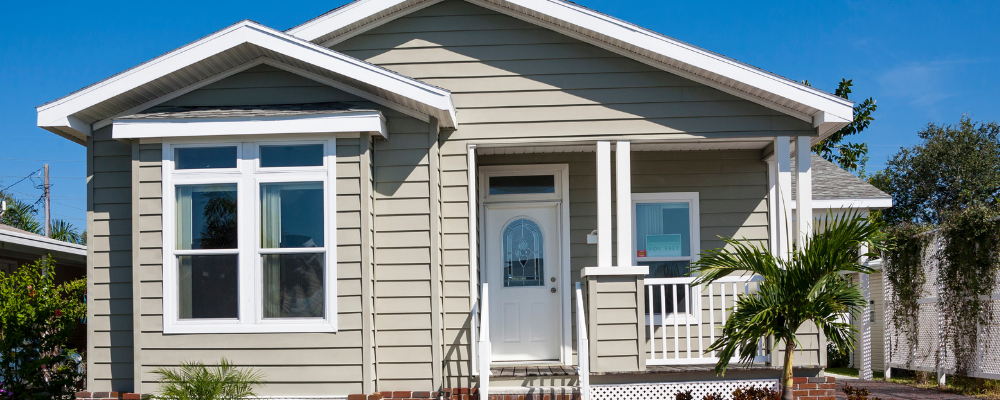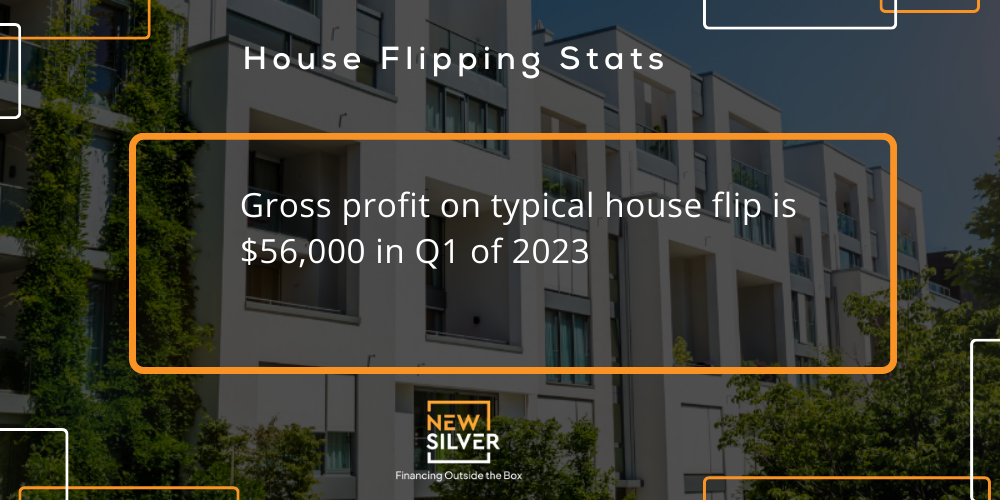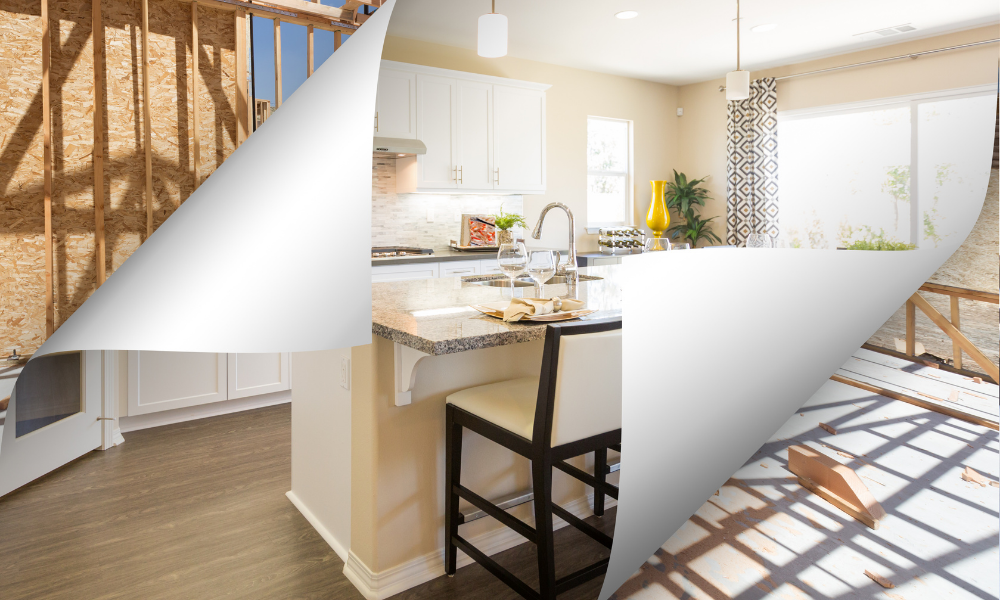The Short Answer
The first and perhaps most vital decision when house flipping is deciding whether an investment property is worth purchasing, for this purpose. This successful real estate investing strategy comes with a few challenges, but careful market research and due diligence can help with this.
Flipping houses is a worthwhile strategy when:
- A property is priced below market value
- The property falls into the 70% rule
- The ARV shows a good profit
- There are distressed properties available on the market
- The demand for homes in the area is high
The gross profit on a house flip is currently $56,000, and over 9% of all properties sold in the US are house flips. In 2023, there has been a clear uptick in interest among buyers in flipped properties, which all bodes well for a real estate investor.
Main Topics
Flipping houses has been made popular recently by the many entertaining shows on TV, however house flipping has long been a successful real estate investment strategy used by many. The strategy involves finding a house that is typically selling below market value, making the necessary repairs and improvements to the house, and then selling it again at a higher price to make a profit. It stands to reason then, that the most important decision for the house flipping process is the initial house purchase. Let’s take a closer look at how to determine if a house is worth flipping.

What do investors look for when trying to find houses to flip?
There are some dos and don’ts for investors who are looking to flip houses, and these can be deal breakers. After all, flipping houses is a business, and it requires a savvy and strategic approach to make good decisions.
Signs that a house is worth flipping
- Priced below market value: A house that is well priced for your purposes is the first kind of house you should consider flipping. The aim is to make a profit, so the lower the price the better, however, keep in mind that lower priced homes may come with larger repairs, so you’ll need to weigh up the price with the work that is needed.
- Property records are suitable: Check out the history of the property to see what price it was sold for before, and how much it is selling for now. You can also make sure that there are no tax liens against the property or any outstanding issues.
- It falls into the 70% rule: We’ll discuss the 70% rule in more detail further on, however it’s worth noting that this tool is an effective way to determine if a house is worth flipping, and houses that don’t fall into this could be a waste of time.
- The ARV shows a good profit: We’ll talk about the ARV later in more depth, but if the property has a high ARV that shows you’ll make a good profit, it stands to reason that it’s likely to be a worthwhile investment.
- Repairs are minor: Minor repairs are a good sign; they show that the house has not fallen into disrepair entirely and you won’t need to spend too much getting it fixed up and ready to sell again. The less you can spend, the better, and the higher your profit will be if you can do the right improvements.
Signs that a house is not worth flipping
- Overpriced: If a house is priced above your budget, or far above market value then it’s more than likely not a worthwhile house to flip. You’re trying to make a profit with the flip, so any house that is priced too high will make that goal difficult or perhaps even impossible to achieve.
- High running costs: You may not need to keep the home for a long time while you’re fixing it up, but high running costs can be a deterrent. Particularly if there are outstanding bills. So, make sure to check the HOA fees, utility costs, property taxes and so on, before you decide if the house is worth flipping.
- Major repairs: A house that has major repairs could end up costing more to fix than is worthwhile. If you come across major repairs immediately, such as a damaged roof or any foundation problems, you may want to move onto another home as these will be costly to fix.

Viewing houses through the lens of After Repair Value
The After Repair Value (ARV) is one of the most important numbers to know when it comes to house flipping. This calculation will help you determine if a house is worthwhile flipping or not, based on what it will be worth once the repairs are completed. The ARV value is helpful for 3 reasons:
- Estimate how much the property will be worth once the repairs are completed
- Work out how much you should buy the property for
- Figure out how much you should spend on repairs and renovations
When you’re looking at how to calculate the ARV, you’ll need to:
- Estimate the house’s current value by getting it appraised or using another method. The ARV uses both the current value and the value of the repairs to estimate how much the house will be worth once the repairs are complete.
- Work out the total value of the repairs and renovations. First, you’ll need to work out the potential cost of the renovations, and from there you can determine the value of these renovations in terms of how much profit they will generate for you.
- Consider similar houses in the area, also known as comparable properties or comps. This is called a Comparative Market Analysis (CMA). These houses should be a similar size in square feet, have the same number of bedrooms and bathrooms, and be a similar age. From these properties you can get a good idea of what houses in the area are being sold for, and how long they will sit on the market. Make sure to look at homes that have been sold in the last 3-6 months.
The ARV is vital and something to keep in mind when you’re looking at a house to see if it’s a worthwhile investment. You can get a feel for what your ARV will be, by checking out which repairs need to be done and doing your homework on the ROI of these repairs. A quick way to get your ARV is to use an online ARV calculator such as the one New Silver provides for free.
The ARV is a crucial element of the 70% rule, so let’s look at what this is and how to use it when you’re evaluating a property to flip.
Learning how to use the 70% rule
Knowing how much money you can make in a house flipping project is crucial to the decision you’ll be making about whether to go ahead with the property or not. Once you’ve gotten to grips with the ARV, it’s time to use this in your next calculation which can help you determine whether a house is worth flipping.
The 70% rule is a general rule of thumb, which is a useful tool for a real estate investor who is trying to determine the viability of a house for flipping. The idea is that investors should spend no more than 70% of the home’s ARV minus the repair costs and renovations. This is not a hard and fast rule, but it does give real estate investors a good estimate of how much you should spend on buying the house.
Maximum Offer Price = After Repair Value * 70% – Repair Costs
Understanding the risks involved in any house flipping project
While house flipping projects can be a great way to make a profit, there are various risks involved. Here are some of the risks:
- Losing money: One of the biggest risks that investors take when flipping houses is that they could lose money. If you cannot sell the property quick enough, you may have to pay the loan or mortgage, or there may be large repairs or holding costs that end up costing you a lot and taking away from your profits. Unless you do a full inspection of the property before you buy it, and you’re well acquainted with the market to make sure that it sells, you can end up losing out.
- Hidden costs: There can be hidden costs (such as extra repair costs or holding costs) that pose a risk to investors because they can be detrimental to the deal. These hidden costs can come in the form of property taxes, insurance, utilities, repair costs, holding costs and more.
- Bad contractor: If you don’t hire a reputable contractor that comes with good references, you could land up in hot water. A bad contractor can cause your entire deal to fall apart if the work takes too long or is way over budget. Investors should get a detailed timeline for completion of the project upfront, along with a close cost estimate, to avoid this situation.
- Market crash: Some risks simply cannot be foreseen or planned for, such as housing market crashes. These can turn a great house flipping deal into a big problem if the market turns and the house cannot sell, or its value takes a dip. This is not something one can plan for, but it is something to keep watch on, during the process.

Why Flipping Houses Is Worth It
Whether flipping houses is worth it or not to make more money depends on various factors, including your specific circumstances, market conditions, and your ability to manage risks and execute successful house flips. House flipping can be an extremely successful endeavor if the right conditions are met, whether an investor uses a real estate agent or sells the property themselves. There are several considerations to bear in mind for those who decide to flip houses:
Market fluctuations: These can impact profitability, so it’s essential to carefully assess market conditions. House flipping is the most profitable in a strong seller’s market with high demand and limited inventory, as this can increase the chances of selling the flipped property quickly and at a higher price.
Competition: The level of competition in the target market impacts the success of house flipping. If there is a high level of competition among house flippers, it may be more challenging to find suitable properties and achieve high-profit margins when they flip houses, whether they use a real estate agent or not.
Skills and expertise: Successful house flipping requires a combination of real estate knowledge, renovation skills, project management abilities, and a keen eye for identifying opportunities. Assess your expertise and consider partnering with professionals if needed, this can help any investor become more successful.
In recent years, investors have turned to house flipping as the real estate market has been ideal for flips. According to Homelight, the major rise in home prices since 2020, led to a record number of 1 in 10 sold properties being a flipped house, in the first quarter of 2022. According to Attom Data, 9.6% of all home sales in Q1 of 2022 were flipped houses, and 9% of all home sales in Q1 of 2023 were flipped homes. This shows the major significance of house flipping in the overall US real estate market.
Furthermore, Attom Data’s housing report for 2023 revealed that profits and investment returns both increased between Q4 of 2022 and Q1 of 2023. Along with this, there has been a clear uptick in the interest in flipped homes from buyers this year, which makes a house flip an even more profitable strategy. The report from Attom Data also indicates a rise in the typical resale price on a house flip, from $300,000 in the last quarter of 2022, to $305,000 in the first quarter of 2023.
Attom Data’s report shows that the gross profit on typical house flip transactions increased by 4.7% from the previous quarter to land at $56,000 in the first quarter of 2023. This is a 22.5% percent return on investment, which offers real estate investors who flip houses the chance to make a significant profit from these projects.

Challenges Facing House Flippers In 2023 & Beyond
One of the biggest challenges facing house flippers over the near future is the lack of distressed properties. House flipping involves purchasing distressed properties, making improvements, and reselling the properties for a significant profit. However, mortgage delinquencies are on the decline, which means that foreclosure activity is slowing down and providing less opportunities for house flippers and other real estate investors, which can lead to losing money.
According to Attom, about 93% of homes in foreclosure have positive equity in their properties. Which means that some of these homes may not make it to the foreclosure auction, and this adds to the lower number of distressed properties available for real estate investors wanting to do a house flip.
Another challenge facing house flippers is that a large number of prospective home buyers are choosing to rent instead. This means the demand for owning a home is declining, as mortgage rates increase and price potential buyers out of the market. Affordability may remain a problem for some time, and as long as it does, the demand for homes to buy is likely to stay on the lower end. This means that house flippers will have a harder time generating a profit in some areas.
The trick to mitigating these challenges and not losing money is to conduct thorough research on the local real estate market, make careful decisions on where to purchase property and which upgrades to do, and do careful due diligence on each property. It can also be beneficial to consult with experienced flippers or real estate professionals who can provide insights based on their expertise and local market knowledge.
The bottom line
While there are some risks associated with house flipping, these can be mitigated by thorough research and strategic planning wherever possible. House flipping remains one of the most popular real estate investing avenues to make more money and can be a profitable path for new and seasoned investors alike. Provided that investors make the first crucial decision correctly, which is deciding whether an investment property is worth flipping or not.



